How to Cure Rheumatoid Arthritis Permanently
January 31, 2025

Rheumatoid arthritis (RA) is a chronic autoimmune disease. It differs from other forms of arthritis in that it affects the joints on both sides of your body. As a result, you can experience discomfort and inflammation in your:
- Fingers
- Hands
- Wrists
- Knees
- Ankles
- Feet
- Toes
The cartilage in your joints that often serves as a “shock absorber” is damaged by unchecked inflammation. Your joints may distort as a result over time. In addition, your bone itself erodes with time. This can result in your joints “fusing,” an effort by your body to protect itself from constant irritation.
These substances are created in your joints but also go throughout your body and cause symptoms. Rheumatoid arthritis can sometimes affect areas of your body outside just your joints, such as:
- Skin
- Eyes
- Mouth
- Lungs
- Heart
Symptoms
Rheumatoid arthritis (RA) symptoms can vary widely from person to person but commonly include:
- Joint pain and stiffness: Pain, swelling, and warmth in the joints, particularly in the smaller joints such as fingers and toes, are common early signs.
- Morning stiffness: Joint stiffness is most severe in the morning or after long periods of inactivity.
- Fatigue and weakness: Extreme tiredness and a general sense of weakness are common symptoms.
- Systemic symptoms: Fever, decreased appetite, and unexplained weight loss can also occur as the disease impacts the body’s immune system.
- Symmetrical symptoms: RA often affects the same joints on both sides of the body, such as wrists, knees, and elbows.
In some individuals, RA can progress without showing symptoms in the joints, affecting other areas of the body, such as the skin, eyes, lungs, or heart.
Causes
The exact cause of rheumatoid arthritis remains unclear, but experts believe it results from a combination of genetic, environmental, and immune system factors:
- Genetics: Individuals with certain genetic markers, especially variations in the HLA genes, have a higher likelihood of developing RA.
- Immune System Dysfunction: RA develops when the immune system erroneously targets and attacks the body’s own joints, leading to inflammation and damage.
- Environmental Factors: Smoking, infections, or physical and emotional stress can trigger or worsen RA.
- Hormonal Influences: Hormonal changes, particularly in women, may contribute to the development of RA, suggesting a possible connection to sex hormones.
Although the precise cause is still uncertain, recognizing these risk factors can assist in identifying those who may be more prone to developing RA.
Four Stages of Rheumatoid Arthritis?
Rheumatoid arthritis progresses in four stages, with each stage representing increasing severity of joint damage and mobility loss:
1. Stage 1 (Early-stage RA):
- Inflammation affects the joint lining (synovium), causing pain and stiffness. However, there is no bone damage visible on X-rays.
- Treatment at this stage can lead to remission, preventing further joint destruction.
2. Stage 2 (Moderate RA):
- The inflammation begins to damage cartilage and the surrounding bones. Joint movement becomes more restricted, and pain increases.
- Despite cartilage and bone damage, blood tests may still not show signs of RA antibodies.
3. Stage 3 (Severe RA):
- Bone erosion and deformities occur. The joint cartilage wears away, causing bones to rub together, leading to severe pain and limited mobility.
- Permanent changes such as twisted fingers or thickened knuckles may be visible, and symptoms can include muscle weakness.
4. Stage 4 (End-stage RA):
- Joint inflammation ceases, but significant damage remains. Severe pain, swelling, and stiffness persist, with loss of joint function.
- In advanced cases, bones may fuse, leading to total loss of mobility in affected joints.
The progression of these stages can differ significantly from person to person, with some experiencing a slow or halted progression due to treatment, while others may see a faster advancement.
Unusual Symptoms
RA can cause a variety of symptoms beyond joint pain. Some unusual symptoms to watch for include:
- Lung issues: Inflammation caused by RA can affect the lungs, resulting in chest pain, difficulty breathing, or a chronic cough.
- Hearing loss: RA may affect the tiny bones in the inner ear, leading to hearing difficulties.
- Skin nodules: Raised bumps under the skin, often seen in severe RA, may indicate more aggressive disease progression.
- Eye inflammation: Dry eyes, redness, and pain can occur due to inflammation in the eye tissues.
- Heart problems: RA can cause inflammation around the heart, resulting in chest pain or other cardiovascular issues.
- Blood vessel inflammation: Thickening and narrowing of blood vessels due to RA can lead to circulation problems.
- Balance and coordination issues: RA can impact the inner ear, causing issues with balance and dizziness.
- Tinnitus: RA-induced damage to the ear can result in ringing, buzzing, or whistling sounds in the ears.
These symptoms highlight the systemic nature of RA and the importance of recognizing its impact on areas beyond the joints.
Which Doctor is Best for Rheumatoid Arthritis?
While you might first discuss your symptoms with your physician, he or she may recommend that you have additional testing from a rheumatologist or an orthopedist, a physician who focuses on the treatment of inflammatory diseases like arthritis.
Natural Home Remedies
The basic goal of rheumatoid arthritis treatment is to lessen joint pain and swelling. By doing this, joint performance should be maintained or improved. The long-term objective of treatment is to slow or stop joint degeneration. Controlling joint inflammation can improve your quality of life and lessen your discomfort.
Some natural therapies may be able to reduce the pain and stiffness brought on by rheumatoid arthritis, while you’ll still need to receive your normal medical care (RA).
Many of these, like applying heat and cooling, are simple to carry out. However, some, like acupuncture, necessitate the assistance of a trained expert.
If you wish to try natural and at-home therapies, talk to your doctor about what would be best for you and whether there are any limitations on what is appropriate for you. You might wish to look into a few of these well-known treatments, starting with the first three that call for medical advice if your doctor gives you the all-clear.
1. Acupuncture
One of the earliest known natural pain relievers is this type of Chinese traditional medicine. Using extremely fine needles stimulates energy via meridians, or pathways, in your body. Correcting energy, or qi (pronounced “chee”) imbalances is the aim.
There isn’t much evidence specifically on acupuncture for RA, although studies do indicate that treatment lowers levels of chemicals in the body connected to inflammation. Additionally, it eases chronic pain, particularly back pain. Osteoarthritis may also benefit from it.
Ask your rheumatologist to recommend an acupuncturist who treats patients with RA because acupuncture requires using clean, precisely positioned needles.
2. Biofeedback
Using this technique, you can learn to control instinctive reactions like your heart rate and blood pressure. You accomplish it by using body sensors that provide information to a monitor. You gain control over how you react when a therapist puts pressure on you.
3. Massage
This time-tested natural therapy has been shown to be effective in reducing pain by modern research. It has been put to use for countless years. There are many different kinds. You should speak with your doctor before trying it. You can also ask for recommendations. A good option is to select a massage therapist who has experience working with RA patients. Tell them about any uncomfortable areas they should stay away from. You can also ask them to stop using scents that make your skin uncomfortable.
4. Cold and Heat Massage
To reduce the symptoms of rheumatoid arthritis, several experts advise using heat and cold therapies. Each provides several advantages:
Cold: It lessens joint swelling and inflammation. For instance, apply an ice pack to the affected joint when RA flares up. But be careful not to go overboard. Apply the cold compress for 15 minutes each time. Between treatments, give yourself at least 30 minutes.
Heat: It relaxes your muscles and encourages blood flow. Use a warm, damp towel or a moist heating pad. Popular hot-pack heating methods include the microwave. Try not to become too heated. Your skin shouldn’t be burned. You can also employ heat treatment in the shower. Let the warm water touch the area of your body that is hurting. That might make things less tense. A hot tub is another useful tool for relaxing stiff muscles.
If you have high blood pressure or heart problems or are pregnant, you should limit how often you use hot tubs or spas.
5. Exercise
You may not feel like moving, but it’s okay and good as it won’t worsen your RA and might reduce joint swelling and lessen your pain.
Before you begin, discuss your RA with your physician or a physical therapist. They can assist in developing the ideal program for you. It’ll presumably focus on the following:
Aerobic exercise to get your heart pumping, such as walking or swimming
Strength training helps maintain strong muscles around your joints.
Range-of-motion exercises that improve joint range of motion can help your joints function properly.
Balance drills to prevent falls
6. Deep breathing
Take calm, deep breaths from your belly. After turning off the stress receptors that cause your muscles to stiffen up and intensify discomfort, you might feel calmer. Additionally, while you focus on breathing, your thoughts are removed from pain-related ones.
7. Meditation
Simply concentrating on your breathing and monitoring each inhalation and exhalation is a simple way to use this technique. It is independent of extreme tranquility or spiritual convictions. It is doable by everybody, and even a brief period can have an impact. You can be sure that your mind will wander. It’s okay. Simply return your attention to your breathing or another activity of your choice.
8. Turmeric
This golden spice is a member of the ginger family and is commonly used in curries. It comes from India and Indonesia and has long been a mainstay of local traditional medicine there. According to research, it may reduce pain by blocking proteins that produce inflammation.
9. Visualization
This can lessen pain and tension. To attempt this easy exercise:
- Shut your eyes
- Take a deep breath
- Imagine yourself in a tranquil environment
10. Aromatherapy
This natural remedy doesn’t seem to affect the amount of discomfort or the chemicals that lead to inflammation. But it might make you feel better. Lemon fragrance may improve your mood, according to a small study, but that’s about it.
11. Aromatic oils
The use of essential oils during a massage can be pleasant. Exercise caution if you apply them to your skin or let someone else do it. Others are well-known irritants. To gauge your response, try a test patch. Use caution if the skin is broken or injured.
Frequently Asked Questions
1. What foods reverse rheumatoid arthritis?
Fatty Fish: Salmon, mackerel, and tuna provide significant amounts of vitamin D and Omega-3 fatty acids.
Dark Leafy Greens: Spinach, kale, broccoli, and collard greens are excellent sources of vitamins E and C.
Nuts
Olive oil
Berries
Onions and garlic
Green Tea







